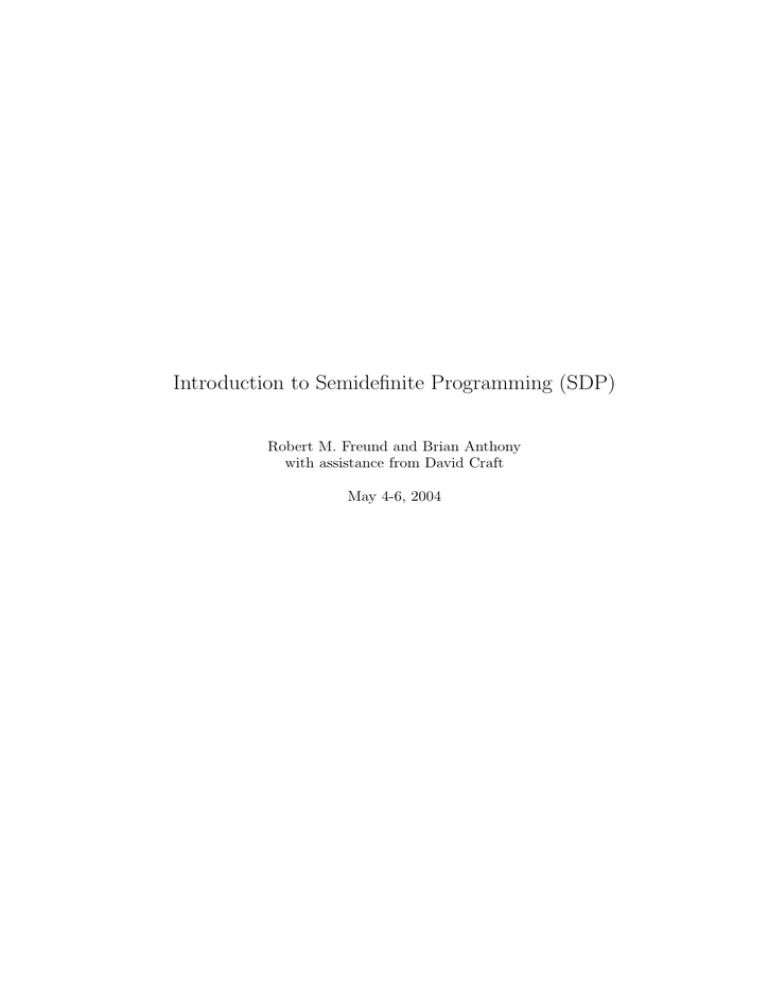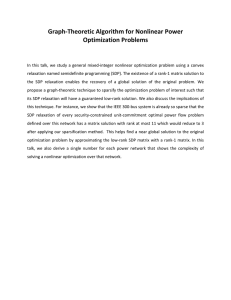Introduction to Semidefinite Programming (SDP)
advertisement

Introduction to Semidefinite Programming (SDP)
Robert M. Freund and Brian Anthony
with assistance from David Craft
May 4-6, 2004
1
Outline
Slide 1
• Alternate View of Linear Programming
• Facts about Symmetric and Semidefinite Matrices
• SDP
• SDP Duality
• Examples of SDP
– Combinatorial Optimization: MAXCUT
– Convex Optimization: Quadratic Constraints, Eigenvalue Problems, log det(X)
problems
• Interior-Point Methods for SDP
• Application: Truss Vibration Dynamics via SDP
2
2.1
Linear Programming
Alternative Perspective
Slide 2
LP :
minimize
c·x
ai · x = bi , i = 1, . . . , m
s.t.
n
x ∈ n
+.
“c · x” means the linear function “ j=1 cj xj ”
n
n
+ := {x ∈ | x ≥ 0} is the nonnegative orthant.
is
a
convex
cone.
n
+
K is convex cone if x, w ∈ K and α, β ≥ 0 ⇒ αx + βw ∈ K.
LP :
minimize
Slide 3
c·x
ai · x = bi , i = 1, . . . , m
s.t.
x ∈ n
+.
“Minimize the linear function c · x, subject to the condition that x must solve m given
equations ai · x = bi , i = 1, . . . , m, and that x must lie in the convex cone K = n
+ .”
2.1.1 LP Dual Problem
LD :
Slide 4
maximize
m
y i bi
i=1
m
s.t.
i=1
yi a i + s = c
s ∈ n
+.
1
For feasible solutions x of LP and (y, s) of LD, the duality gap is simply
c·x−
m
y i bi =
c−
i=1
m
yi a i
·x=s·x≥0
i=1
If LP and LD are feasible, then there exists x∗ and (y ∗ , s∗ ) feasible for the primal and
dual, respectively, for which
c · x∗ −
m
Slide 5
yi∗ bi = s∗ · x∗ = 0
i=1
3
Facts about the Semidefinite Cone
If X is an n × n matrix, then X is a symmetric positive semidefinite (SPSD) matrix
if X = X T and
v T Xv ≥ 0 for any v ∈ n
Slide 6
If X is an n × n matrix, then X is a symmetric positive definite (SPD) matrix if
X = X T and
v T Xv > 0 for any v ∈ n , v =
0
4
Facts about the Semidefinite Cone
S n denotes the set of symmetric n × n matrices
n
denotes the set of (SPSD) n × n matrices.
S+
n
denotes the set of (SPD) n × n matrices.
Let X, Y ∈ S n .
S++
“X 0” denotes that X is SPSD
“X Y ” denotes that X − Y 0
“X 0” to denote that X is SPD, etc.
n
= {X ∈ S n | X 0} is a convex cone.
Remark: S+
5
Slide 7
Slide 8
Facts about Eigenvalues and Eigenvectors
If M is a square n × n matrix, then λ is an eigenvalue of M with corresponding
eigenvector q if
M q = λq and q =
0.
Slide 9
Let λ1 , λ2 , . . . , λn enumerate the eigenvalues of M .
6
Facts about Eigenvalues and Eigenvectors
The corresponding eigenvectors q 1 , q 2 , . . . , q n of M can be chosen so that they are
orthonormal, namely
i T j q
q
= 0 for i = j, and
2
i T i q
q
=1
Slide 10
Define:
Q := q 1 q 2 · · · q n
Then Q is an orthonormal matrix:
QTQ = I, equivalently QT = Q−1
Slide 11
λ1 , λ2 , . . . , λn are the eigenvalues of M
q 1 , q 2 , . . . , q n are the corresponding orthonormal eigenvectors of M
Q := q 1 q 2 · · · q n
QT Q = I, equivalently QT = Q−1
λ
Define D:
1
0
D :=
0
λ2
0
..
.
.
0
λn
Property: M = QDQT .
The decomposition of M into M = QDQT is called its eigendecomposition.
7
Slide 12
Facts about Symmetric Matrices
• If X ∈ S n , then X = QDQT for some orthonormal matrix Q and some diagonal
matrix D. The columns of Q form a set of n orthogonal eigenvectors of X,
whose eigenvalues are the corresponding entries of the diagonal matrix D.
Slide 13
• X 0 if and only if X = QDQT where the eigenvalues (i.e., the diagonal entries
of D) are all nonnegative.
• X 0 if and only if X = QDQT where the eigenvalues (i.e., the diagonal entries
of D) are all positive.
Slide 14
• If M is symmetric, then
det(M ) =
n
λj
j=1
Slide 15
• Consider the matrix M defined as follows:
M=
P
vT
v
d
,
where P 0, v is a vector, and d is a scalar. Then M 0 if and only if
d − v T P −1
v ≥ 0.
• For a given column vector a, the matrix X := aaT is SPSD, i.e., X = aaT 0.
• If M 0, then there is a matrix N for which M = N T N . To see this, simply
1
take N = D 2 QT .
3
8
SDP
8.1
8.1.1
Semidefinite Programming
Think about X
Slide 16
Let X ∈ S n . Think of X as:
• a matrix
• an array of n2 components of the form (x11 , . . . , xnn )
• an object (a vector) in the space S n .
All three different equivalent ways of looking at X will be useful.
8.1.2
Linear Function of X
Let X ∈ S n . What will a linear function of X look like?
If C(X) is a linear function of X, then C(X) can be written as C • X, where C • X :=
n
n
Slide 17
Cij Xij .
i=1 j=1
There is no loss of generality in assuming that the matrix C is also symmetric.
8.1.3
Definition of SDP
SDP :
Slide 18
C•X
minimize
Ai • X = bi , i = 1, . . . , m,
s.t.
X 0,
n
”
“X 0” is the same as “X ∈ S+
The data for SDP consists of the symmetric matrix C (which is the data for the
objective function) and the m symmetric matrices A1 , . . . , Am , and the m−vector b,
which form the m linear equations.
8.1.4
Example
A1 =
1
0
1
0
3
7
1
7
5
,
A2 =
0
2
8
2
6
0
8
0
4
, b=
11
19
The variable X will be the 3 × 3 symmetric matrix:
X=
x11
x21
x31
x12
x22
x32
4
x13
x23
x33
, and C =
,
1
2
3
2
9
0
3
0
7
Slide 19
,
SDP :
x11 + 4x12 + 6x13 + 9x22 + 0x23 + 7x33
x11 + 0x12 + 2x13 + 3x22 + 14x23 + 5x33
0x11 + 4x12 + 16x13 + 6x22 + 0x23 + 4x33
minimize
s.t.
X =
SDP :
minimize
s.t.
x11
x21
x31
x12
x22
x32
x13
x23
x33
=
=
0.
Slide 20
x11 + 4x12 + 6x13 + 9x22 + 0x23 + 7x33
x11 + 0x12 + 2x13 + 3x22 + 14x23 + 5x33
0x11 + 4x12 + 16x13 + 6x22 + 0x23 + 4x33
X=
x11
x21
x31
x12
x22
x32
x13
x23
x33
11
19
=
=
11
19
0.
It may be helpful to think of “X 0” as stating that each of the n eigenvalues of X must be
nonnegative.
8.1.5 LP ⊂ SDP
Slide 21
LP :
Define:
ai1
Ai =
0
.
.
.
0
0
ai2
.
.
.
0
SDP :
9
...
...
..
.
...
minimize
s.t.
c·x
ai · x = bi , i = 1, . . . , m
x ∈ n
+.
0
0
. , i = 1, . . . , m, and C =
.
.
ain
minimize
s.t.
c1
0
.
.
.
0
0
c2
.
.
.
0
...
...
..
.
...
0
0
. .
.
.
cn
C•X
Ai • X = bi , i = 1, . . . , m,
Xij = 0, i = 1, . . . , n, j = i + 1, . . . , n,
x1 0 . . . 0
0
0 x2 . . .
X = .
.
. 0,
..
.
.
.
.
.
.
.
0
0 . . . xn
SDP Duality
SDD :
maximize
m
i=1
m
s.t.
i=1
Slide 22
y i bi
yi A i + S = C
S 0.
Notice
m
S = C −
i=1
5
yi A i 0
10
SDP Duality
Slide 23
and so equivalently:
SDD :
maximize
m
i=1
C−
s.t.
10.1
y i bi
m
i=1
yi A i 0
Example
A1 =
1
0
1
SDD :
0
3
7
1
7
5
,
maximize
A2 =
2
6
0
8
0
4
, b=
11
19
, and C =
1
2
3
2
9
0
3
0
7
Slide 24
,
11y1 + 19y2
s.t.
0
2
8
y1
1
0
1
0
3
7
1
7
5
+ y2
0
2
8
2
6
0
8
0
4
+S =
1
2
3
2
9
0
3
0
7
S0
SDD :
maximize
s.t.
Slide 25
11y1 + 19y2
y1
1
0
1
0
3
7
1
7
5
+ y2
0
2
8
2
6
0
8
0
4
+S =
1
2
3
2
9
0
3
0
7
S0
is the same as:
SDD : maximize
s.t.
10.2
11y1 + 19y2
1 − 1y1 − 0y2
2 − 0y1 − 2y2
3 − 1y1 − 8y2
2 − 0y1 − 2y2
9 − 3y1 − 6y2
0 − 7y1 − 0y2
3 − 1y1 − 8y2
0 − 7y1 − 0y2
7 − 5y1 − 4y2
0.
Weak Duality
Weak Duality Theorem: Given a feasible solution X of SDP and a feasible solution
(y, S) of SDD, the duality gap is
C •X −
m
y i bi = S • X ≥ 0 .
i=1
If
C•X−
m
y i bi = 0 ,
i=1
then X and (y, S) are each optimal solutions to SDP and SDD, respectively, and
furthermore, SX = 0.
6
Slide 26
10.3
Strong Duality
∗
Strong Duality Theorem: Let zP∗ and zD
denote the optimal objective function
values of SDP and SDD, respectively. Suppose that there exists a feasible solution
ˆ of SDP such that X
ˆ 0, and that there exists a feasible solution (ˆ
X
y, Ŝ) of SDD
such that Ŝ 0. Then both SDP and SDD attain their optimal values, and
Slide 27
∗
.
zP∗ = zD
11
Some Important Weaknesses of SDP
Slide 28
• There may be a finite or infinite duality gap.
• The primal and/or dual may or may not attain their optima.
• Both programs will attain their common optimal value if both programs have
feasible solutions that are SPD.
• There is no finite algorithm for solving SDP .
• There is a simplex algorithm, but it is not a finite algorithm. There is no direct
analog of a “basic feasible solution” for SDP .
12
12.0.1
SDP in Combinatorial Optimization
The MAX CUT Problem
G is an undirected graph with nodes N = {1, . . . , n} and edge set E.
Let wij = wji be the weight on edge (i, j), for (i, j) ∈ E.
We assume that wij ≥ 0 for all (i, j) ∈ E.
The MAX CUT problem is to determine a subset S of the nodes N for which the
sum of the weights of the edges that cross from S to its complement S¯ is maximized
(S̄ := N \ S).
12.0.2
Formulations
Slide 29
Slide 30
The MAX CUT problem is to determine a subset S of the nodes N for which the sum
of the weights wij of the edges that cross from S to its complement S¯ is maximized
(S̄ := N \ S).
Let xj = 1 for j ∈ S and xj = −1 for j ∈ S̄.
M AXCU T :
1
4
maximizex
s.t.
n n
wij (1 − xi xj )
i=1 j=1
xj ∈ {−1, 1}, j = 1, . . . , n.
Slide 31
M AXCU T :
1
4
maximizex
s.t.
n
n
i=1 j=1
wij (1 − xi xj )
xj ∈ {−1, 1}, j = 1, . . . , n.
7
Let
Y = xxT .
Then
Yij = xi xj
i = 1, . . . , n, j = 1, . . . , n.
Also let W be the matrix whose (i, j)th element is wij for i = 1, . . . , n and j = 1, . . . , n.
Then
M AXCU T :
1
4
maximizeY,x
n
n i=1 j=1
Slide 32
wij − W • Y
xj ∈ {−1, 1}, j = 1, . . . , n
s.t.
Y = xxT .
Slide 33
M AXCU T :
1
4
maximizeY,x
n n
i=1 j=1
wij − W • Y
xj ∈ {−1, 1}, j = 1, . . . , n
s.t.
Y = xxT .
Slide 34
The first set of constraints are equivalent to Yjj = 1, j = 1, . . . , n.
M AXCU T :
1
4
maximizeY,x
n n
i=1 j=1
wij − W • Y
Yjj = 1, j = 1, . . . , n
s.t.
Y = xxT .
Slide 35
M AXCU T :
1
4
maximizeY,x
n n
i=1 j=1
wij − W • Y
Yjj = 1, j = 1, . . . , n
s.t.
Y = xxT .
Notice that the matrix Y = xxT is a rank-1 SPSD matrix.
We relax this condition by removing the rank-1 restriction:
RELAX :
1
4
maximizeY
s.t.
n n
i=1 j=1
wij − W • Y
Yjj = 1, j = 1, . . . , n
Y 0.
It is therefore easy to see that RELAX provides an upper bound on MAXCUT, i.e.,
8
Slide 36
M AXCU T ≤ RELAX.
Slide 37
RELAX :
1
4
maximizeY
n
n i=1 j=1
wij − W • Y
Yjj = 1, j = 1, . . . , n
s.t.
Y 0.
As it turns out, one can also prove without too much effort that:
0.87856 RELAX ≤ M AXCU T ≤ RELAX.
Slide 38
This is an impressive result, in that it states that the value of the semidefinite
relaxation is guaranteed to be no more than 12.2% higher than the value of
N P -hard problem MAX CUT.
13
SDP for Convex QCQP
A convex quadratically constrained quadratic program (QCQP) is a problem of the
form:
QCQP :
minimize
x
s.t.
Slide 39
xT Q0 x + q0T x + c0
xT Qi x + qiT x + ci ≤ 0 , i = 1, . . . , m,
where the Q0 0 and Qi 0, i = 1, . . . , m. This is the same as:
QCQP :
minimize
x, θ
s.t.
θ
xT Q0 x + q0T x + c0 − θ ≤ 0
xT Qi x + qiT x + ci ≤ 0 , i = 1, . . . , m.
Slide 40
QCQP :
minimize
x, θ
s.t.
θ
xT Q0 x + q0T x + c0 − θ ≤ 0
xT Qi x + qiT x + ci ≤ 0 , i = 1, . . . , m.
Factor each Qi into
Qi = MiT Mi
and note the equivalence:
I
xT MiT
Mi x
−ci − qiT x
0
⇐⇒
xT Qi x + qiT x + ci ≤ 0.
Slide 41
9
QCQP :
minimize
x, θ
s.t.
θ
xT Q0 x + q0T x + c0 − θ ≤ 0
xT Qi x + qiT x + ci ≤ 0 , i = 1, . . . , m.
Re-write QCQP as:
QCQP :
minimize
x, θ
θ
s.t.
I
M0 x
−c0 − q0T x + θ
I
Mi x
−ci − qiT x
xT M0T
xT MiT
14
14.1
0
0 , i = 1, . . . , m.
SDP for SOCP
Second-Order Cone Optimization
Slide 42
Second-order cone optimization:
SOCP :
minx
cT x
s.t.
Ax = b
Recall v
:=
√
Qi x + di ≤ giT x + hi
,
i = 1, . . . , k .
vT v
SOCP :
Slide 43
minx
cT x
s.t.
Ax = b
Qi x + di ≤ giT x + hi
Property:
Qx + d ≤ g T x + h
⇐⇒
(g T x + h)I
(Qx + d)T
,
i = 1, . . . , k .
(Qx + d)
gT x + h
0.
This property is a direct consequence of the fact that
M =
P
vT
v
d
0 ⇐⇒ d − vT P −1 v ≥ 0 .
Slide 44
SOCP :
minx
cT x
s.t.
Ax = b
Qi x + di ≤ giT x + hi
Re-write as:
10
,
i = 1, . . . , k .
SDPSOCP :
minx
cT x
s.t.
Ax = b
(giT x + hi )I
(Qi x + di )T
15
(Qi x + di )
giT x + hi
0,
i = 1, . . . , k .
Eigenvalue Optimization
Slide 45
We are given symmetric matrices B and Ai , i = 1, . . . , k
Choose weights w1 , . . . , wk to create a new matrix S:
S := B −
k
wi Ai .
i=1
There might be restrictions on the weights Gw ≤ d.
The typical goal is for S is to have some nice property such as:
• λmin (S) is maximized
• λmax (S) is minimized
• λmax (S) − λmin (S) is minimized
15.1
Some Useful Relationships
Slide 46
Property: M tI if and only if λmin (M ) ≥ t.
Proof: M = QDQT . Define
R = M − tI = QDQT − tI = Q(D − tI)QT .
M tI ⇐⇒ R 0 ⇐⇒ D − tI 0 ⇐⇒ λmin (M ) ≥ t . q.e.d.
Property: M tI if and only if λmax (M ) ≤ t.
15.2
Design Problem
Slide 47
Consider the design problem:
EOP :
minimize
w, S
s.t.
λmax (S) − λmin (S)
S=B−
k
wi Ai
i=1
Gw ≤ d .
Slide 48
11
EOP :
λmax (S) − λmin (S)
minimize
w, S
S=B−
s.t.
k
i=1
w i Ai
Gw ≤ d .
This is equivalent to:
EOP :
µ − λ
minimize
w, S, µ, λ
S=B−
s.t.
Gw ≤ d
λI S µI.
k
w i Ai
i=1
16 The Logarithmic Barrier Function for SPD
Matrices
n
Let X 0, equivalently X ∈ S+
.
X will have n nonnegative eigenvalues, say λ1 (X), . . . , λn (X) ≥ 0 (possibly counting
multiplicities).
Slide 49
n
= {X ∈ S n | λj (X) ≥ 0, j = 1, . . . , n,
∂S+
and λj (X) = 0 for some j ∈ {1, . . . , n}}.
Slide 50
n
∂S+
= {X ∈ S n | λj (X) ≥ 0, j = 1, . . . , n,
and λj (X) = 0 for some j ∈ {1, . . . , n}}.
A natural barrier function is:
B(X) := −
n
ln(λi (X)) = − ln
j=1
n
= − ln(det(X)).
λi (X)
j=1
This function is called the log-determinant function or the logarithmic barrier function
for the semidefinite cone.
B(X) := −
n
ln(λi (X)) = − ln
j=1
λi (X)
= − ln(det(X)).
j=1
¯
Quadratic Taylor expansion at X = X:
¯ + αD) ≈ B(X)
¯ + αX
¯ −1 • D +
B(X
n
1
1 2 ¯− 1
α X 2 D X̄ − 2
2
1
1
• X̄ − 2 D X̄ − 2
.
B(X) has the same remarkable
properties in the context of interior-point methods for
n
SDP as the barrier function − j=1 ln(xj ) does in the context of linear optimization.
12
Slide 51
17
The SDP Analytic Center Problem
Slide 52
Given a system:
m
yi Ai C ,
i=1
ˆ of:
the analytic center is the solution (ˆ
y, S)
(ACP:)
n
maximizey,S
m
s.t.
λi (S)
i=1
i=1
yi Ai + S = C
S0.
(ACP:)
n
maximizey,S
i=1
m
s.t.
i=1
Slide 53
λi (S)
yi Ai + S = C
S0.
This is the same as:
(ACP:)
− ln det(S)
minimizey,S
m
s.t.
i=1
yi Ai + S = C
S0.
Slide 54
(ACP:)
− ln det(S)
minimizey,S
m
s.t.
i=1
yi Ai + S = C
S0.
Let (ŷ, Ŝ) be the analytic center.
There are easy-to-construct ellipsoids EIN and EOUT , both centered at ŷ and where EOUT is
a scaled version of EIN with scale factor n, with the property that:
EIN ⊂ P ⊂ EOUT
Slide 55
13
^
x
P
Ein
Eout
18
Minimum Volume Circumscription
R 0 and z ∈ n define an ellipsoid in n :
ER,z := {y | (y − z)T R(y − z) ≤ 1}.
The volume of ER,z is proportional to det(R−1 ).
Given k points c1 , . . . , ck , we would like to find an ellipsoid circumscribing
c1 , . . . , ck that has minimum volume:
14
Slide 56
Slide 57
Slide 58
M CP :
minimize
R, z
s.t.
vol (ER,z )
ci ∈ ER,z , i = 1, . . . , k
which is equivalent to:
M CP :
minimize
R, z
s.t.
− ln(det(R))
(ci − z)T R(ci − z) ≤ 1, i = 1, . . . , k
R0
Slide 59
M CP :
minimize
R, z
s.t.
− ln(det(R))
(ci − z)T R(ci − z) ≤ 1, i = 1, . . . , k
R0
Factor R = M 2 where M 0 (that is, M is a square root of R):
M CP :
minimize
M, z
s.t.
− ln(det(M 2 ))
(ci − z)T M T M (ci − z) ≤ 1, i = 1, . . . , k,
M 0
Slide 60
15
M CP :
minimize
M, z
s.t.
− ln(det(M 2 ))
(ci − z)T M T M (ci − z) ≤ 1, i = 1, . . . , k,
M 0.
Notice the equivalence:
I
(M ci − M z)T
M ci − M z
1
0
⇐⇒
(ci − z)T M T M (ci − z) ≤ 1
Re-write M CP :
M CP :
minimize
M, z
s.t.
−2 ln(det(M ))
I
(M ci − M z)T
M 0.
M ci − M z
1
0, i = 1, . . . , k,
Slide 61
M CP :
minimize
M, z
s.t.
−2 ln(det(M ))
I
(M ci − M z)T
M 0.
M ci − M z
1
0, i = 1, . . . , k,
Substitute y = M z:
M CP :
minimize
M, y
s.t.
−2 ln(det(M ))
I
(M ci − y)T
M 0.
M ci − y
1
0, i = 1, . . . , k,
Slide 62
M CP :
minimize
M, y
s.t.
−2 ln(det(M ))
I
(M ci − y)T
M 0.
M ci − y
1
0, i = 1, . . . , k,
This problem is very easy to solve.
Recover the original solution R, z by computing:
R = M 2 and z = M −1 y.
19 SDP in Control Theory
A variety of control and system problems can be cast and solved as instances of
SDP . This topic is beyond the scope of this lecturer’s expertise.
16
Slide 63
20 Interior-p oint Methods for SDP
20.1
Primal and Dual SDP
SDP :
minimize
s.t.
Slide 64
C •X
Ai • X = bi , i = 1, . . . , m,
X 0
and
SDD :
m
maximize
yi bi
i=1
m
s.t.
yi Ai + S = C
i=1
S0.
If X and (y, S) are feasible for the primal and the dual, the duality gap is:
C •X −
m
yi bi = S • X ≥ 0 .
i=1
Also,
S • X = 0 ⇐⇒ SX = 0 .
B(X) = −
n
ln(λi (X)) = − ln
j=1
n
Slide 65
λi (X)
= − ln(det(X)) .
j=1
Consider:
BSDP (µ) :
minimize
s.t.
C • X − µ ln(det(X))
Ai • X = bi , i = 1, . . . , m,
X 0.
Let fµ (X) denote the objective function of BSDP (µ). Then:
−∇fµ (X) = C − µX −1
Slide 66
BSDP (µ) :
minimize
s.t.
C • X − µ ln(det(X))
Ai • X = bi , i = 1, . . . , m,
X 0.
∇fµ (X) = C − µX −1
Karush-Kuhn-Tucker conditions for BSDP (µ) are:
Ai • X = bi , i = 1, . . . , m,
X 0,
m
yi Ai .
C − µX −1 =
i=1
17
Slide 67
A • X = bi , i = 1, . . . , m,
i
X 0,
m
C − µX −1 =
yi A i .
i=1
Define
S = µX −1 ,
which implies
XS = µI ,
and rewrite KKT conditions as:
Slide 68
Ai • X = bi , i = 1, . . . , m, X 0
m
yi Ai + S = C
i=1
XS = µI.
Slide 69
Ai • X = bi , i = 1, . . . , m, X 0
m
yi Ai + S = C
i=1
XS = µI.
If (X, y, S) is a solution of this system, then X is feasible for SDP , (y, S) is feasible
for SDD, and the resulting duality gap is
S •X =
n
n
Sij Xij =
i=1 j=1
n
(SX)jj =
j=1
n
(µI)jj = nµ.
j=1
Slide 70
Ai • X = bi , i = 1, . . . , m, X 0
m
yi Ai + S = C
i=1
XS = µI.
If (X, y, S) is a solution of this system, then X is feasible for SDP , (y, S) is feasible
for SDD, the duality gap is
S • X = nµ.
This suggests that we try solving BSDP (µ) for a variety of values of µ as µ → 0.
Interior-point methods for SDP are very similar to those for linear optimization, in
that they use Newton’s method to solve the KKT system as µ → 0.
21
Slide 71
Website for SDP
Slide 72
A good website for semidefinite programming is:
http://www-user.tu-chemnitz.de/ helmberg/semidef.html.
18
22
22.1
Optimization of Truss Vibration
Motivation
• The design and analysis of trusses are found in a wide variety of scientific ap-
plications including engineering mechanics, structural engineering, MEMS, and
biomedical engineering.
Slide 73
• As finite approximations to solid structures, a truss is the fundamental concept
of Finite Element Analysis.
• The truss problem also arises quite obviously and naturally in the design of
scaffolding-based structures such as bridges, the Eiffel tower, and the skeletons
for tall buildings.
Slide 74
• Using semidefinite programming (SDP) and the interior-point software SDPT3,
we will explore an elegant and powerful technique for optimizing truss vibration
dynamics.
• The problem we consider here is designing a truss such that the lowest frequency
¯
Ω at which it vibrates is above a given lower bound Ω.
• November 7, 1940, Tacoma Narrows Bridge in Tacoma, Washington
22.2
The Dynamics Model
Slide 75
Newton’s Second Law of Motion:
F =m×a .
k
m
u
Slide 76
19
k
m
u
If the mass is pulled down, the displacement u produces a force in the spring tending
to move the mass back to its equilibrium point (where u = 0). The displacement u causes an upward force k × u, where k is the spring constant.
We obtain from F = m × a that:
−ku(t) = mü(t)
Slide 77
Law of Motion:
−ku(t) = mü(t)
Solution:
u(t) = sin
Frequency of vibration:
ω=
22.2.1
k
t
m
k
.
m
Apply to Truss Structure
Slide 78
Law of Motion:
−ku(t) = mü(t)
Solution:
u(t) = sin
k
t
m
ω=
k
m
For truss structure, we need multidimensional analogs for k, u(t), and m.
A simple truss.
Each bar has both stiffness and mass that depend on material properties and the bar’s
cross-sectional area.
20
Slide 79
5 feet
6 feet
10 feet
22.2.2
Analog of k
Slide 80
The spring constant k extends to the stiffness matrix of a truss.
We used G to denote the stiffness matrix.
Here we will use K.
K = G = AB −1 AT
Each column of A, denoted as ai , is the projection of bar i onto the degrees of freedom
of the nodes that bar i meets.
B=
L2
1
E1 t 1
0
..
0
22.2.3
.
E1 t 1
B −1 =
,
L2
m
Em t m
0
2
L1
..
0
.
.
Em t m
L2
m
Analog of m
Instead of a single displacement scalar u(t), we have N degrees of freedom, and the
vector
u(t) = (u1 (t), . . . , uN (t))
Slide 81
is the vector of displacements.
The mass m extends to a mass matrix M
22.2.4
Laws of Motion
Slide 82
−ku(t) = mu(t)
¨
21
becomes:
−Ku(t) = M ü(t)
Both K and M are SPD matrices, and are easily computed once the truss geometry
and the nodal constraints are specified.
Slide 83
−Ku(t) = M ü(t)
The truss structure vibration involves sine functions with frequencies
√
ωi = λi
where
λ1 , . . . , λ N
are the eigenvalues of
M −1 K
The threshold frequency Ω of the truss is the lowest frequency ωi , i = 1, . . . , N , or
equivalently, the square root of the smallest eigenvalue of M −1 K.
Slide 84
−Ku(t) = M ü(t)
The threshold frequency Ω of the truss is the square root of the smallest eigenvalue of
M −1 K.
Lower bound constraint on the threshold frequency
¯
Ω≥Ω
Property:
22.3
¯ ⇐⇒ K − Ω
¯ 2M 0 .
Ω≥Ω
Truss Vibration Design
We wrote the stiffness matrix as a linear function of the volumes ti of the bars i:
K=
m
Ei
ti
i=1
L2i
Slide 85
(ai )(ai )T ,
Li is the length of bar i
Ei is the Young’s modulus of bar i
ti is the volume of bar i.
22.4
Truss Vibration Design
Here we use yi to represent the area of bar i (yi =
m Ei
K = K(y) = i=1
where
Ki =
Li
Slide 86
ti
)
Li
(ai )(ai )T yi =
m
Ki yi
i=1
Ei
(ai )(ai )T
Li
22
, i = 1, . . . , m
Slide 87
There are matrices M1 , . . . , Mm for which we can write the mass matrix as a linear
function of the areas y1 , . . . , ym :
M = M (y) =
m
Mi yi
i=1
In truss vibration design, we seek to design a truss of minimum weight whose threshold
¯
frequency Ω is at least a pre-specified value Ω.
T SDP :
minimize
m
Slide 88
bi yi
i=1
m
s.t.
¯ 2 Mi )yi 0
(Ki − Ω
i=1
li ≤ yi ≤ ui , i = 1, . . . , m .
The decision variables are y1 , . . . , ym
li , ui are bounds on the area yi of bar i (perhaps from the output of the static truss
design model)
bi is the length of bar i times the material density of bar i
T SDP :
minimizey
m
Slide 89
Slide 90
bi yi
i=1
m
s.t.
¯ 2 Mi )yi 0
(Ki − Ω
i=1
li ≤ yi ≤ ui , i = 1, . . . , m .
22.5
Computational Example
Slide 91
m
T SDP :
s.t.
minimizey
bi yi
i=1
m
i=1
¯ 2 Mi )yi 0
(Ki − Ω
li ≤ yi ≤ ui , i = 1, . . . , m .
23
5 feet
6 feet
10 feet
T SDP :
minimizey
Slide 92
m
bi yi
i=1
m
s.t.
¯ 2 Mi )yi 0
(Ki − Ω
i=1
li ≤
yi ≤ ui , i = 1, . . . , m .
• li = 5.0 square inches for all bars i
• ui = 8.0 square inches for all bars i
• mass density for steel, which is ρ =0.736e−03
• Young’s modulus for steel, which is 3.0e+07 pounds per square inch
¯ = 220Hz
• Ω
22.5.1
SDPT3
Slide 93
SDPT3 is the semidefinite programming software developed by “T3”:
• Kim Chuan Toh of National University of Singapore
• Reha T¨
ut¨
unçu of Carnegie Mellon University
• Michael Todd of Cornell University
Slide 94
Statistics for TSDP problem run using SDPT3
Linear Inequalities
Semidefinite block size
CPU time (seconds):
IPM Iterations:
Optimal Solution
Bar 1 area (square inches)
Bar 2 area (square inches)
Bar 3 area (square inches)
Bar 4 area (square inches)
Bar 5 area (square inches)
Bar 6 area (square inches)
Bar 7 area (square inches)
24
14
6×6
0.8
15
8.0000
8.0000
7.1797
6.9411
5.0000
6.9411
7.1797
Slide 95
5 feet
6 feet
10 feet
22.6
More Computation
A truss tower used for computational experiments. This version of the tower has 40
bars and 32 degrees of freedom.
25
Slide 96
tower
100
90
80
70
60
50
40
30
20
10
0
60
40
20
0
20
40
60
Slide 97
Computational results using SDPT3 for truss frequency optimization.
Semidefinite
Linear
Scalar
IPM
CPU time
Block
Inequalities Variables
Iterations
(sec)
12 × 12
30
15
17
1.17
20 × 20
50
25
20
1.49
32 × 32
80
40
21
1.88
48 × 48
120
60
20
2.73
60 × 60
150
75
20
3.76
80 × 80
200
100
23
5.34
120 × 120
300
150
23
9.46
22.6.1
Frontier Solutions
Slide 98
Lower bound on Threshold Frequency Ω versus Weight of Structure
26
5
4.5
4
Weight
3.5
3
2.5
2
1.5
200
205
210
215
220
Ω, lower bound on frequency (Hz)
27
225
230
235





